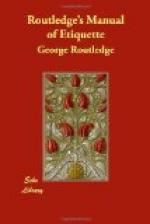The Ring.
The Rubric tells us “the man shall give unto the woman a ring, laying the same upon the book with the accustomed duty to the priest and clerk.” This latter rule is, however, not now observed, it being usual to pay the fees in the vestry; but to ensure the presence of the ring, a caution by no means unnecessary, and in some measure to sanctify that emblem of an eternal union, it is asked for by the clerk previously to the commencement of the ceremony, who advises that it be placed upon the book.
We pity the unfortunate bridegroom who at this moment cannot, by at once inserting his hand into the corner (the one most ready to his finger and thumb) of his left-hand waistcoat-pocket, pull out the wedding ring. Imagine his dismay at not finding it there!—the first surprise, the growing anxiety, as the right-hand pocket is next rummaged—the blank look, as he follows this by the discovery that his neither garments have no pockets whatsoever, not even a watch-fob, where it may lie perdue in a corner! Amid the suppressed giggle of the bridesmaids, the disconcerted look of the bride herself, at such a palpable instance of carelessness on the part of the bridegroom thus publicly displayed before all her friends, and the half-repressed disapprobation of the numerous circle around, he fumbles in the coat-pockets, and turns them inside-out. A further but useless search causes increased confusion and general annoyance; at length it becomes evident that the unfortunate ring has been forgotten! We may observe, however, that in default of the ring, the wedding ring of the mother may be used. The application of the key of the church door is traditionary in this absurd dilemma; and in country churches a straw twisted into a circle has been known to supply the place of the orthodox hoop of gold!
After the Ceremony.
the clergyman usually shakes hands with the bride and bridegroom, and the bride’s father and mother, and a general congratulation ensues.
The Clergyman and Assistant Clergymen.
The clergyman of the church is invariably invited to attend, although the ceremony may be performed by some clerical friend of the bride or bridegroom. This is called “assisting;” other clergymen who may attend in addition, as is sometimes the case, are said also to “assist.” But as much ridicule has fallen upon the adoption of this custom, and as the expression of “assisting” is considered an affectation, it is much less in vogue than it was; and it is no longer usual to mention the names of any other clergymen than that of the one who performs the ceremony, and of the clergyman of the church, who should be present whether invited or not. It is, indeed, his duty to attend, and he should insist on so doing, inasmuch as the entry of the marriage in the parish register is supposed to be made under his sanction and authority. It should not be forgotten that the presence of an “assisting clergyman” entails the doubling of the fees. The payment of the fees is generally entrusted to the bridegroom’s “best man,” or some other intimate friend of his.




